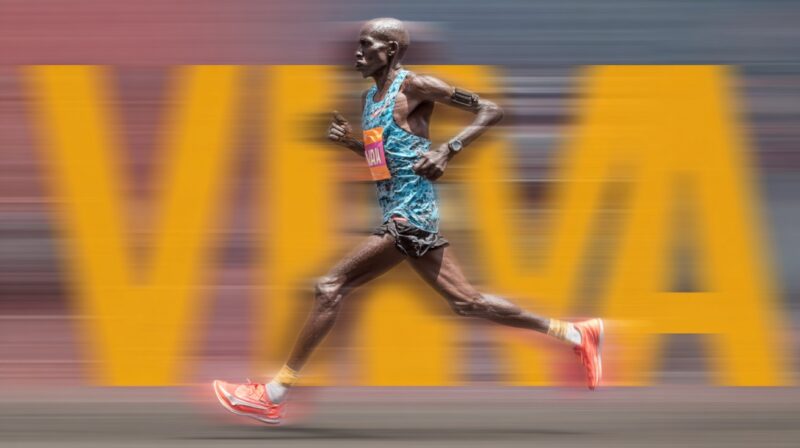VMA, or Maximum Aerobic Speed, represents the minimum speed at which a runner reaches their maximum oxygen consumption (VO2max). It’s one of the most effective metrics for evaluating endurance capacity and overall fitness.
For runners of all levels, understanding VMA transforms how training is approached. It helps fine-tune workouts, avoid plateaus, and maintain steady progress without overexertion.
- Optimized training sessions for endurance, tempo, and intervals.
- Reduced injury risk through controlled effort levels.
- Reliable progress tracking using measurable data instead of guesswork.
Knowing your VMA means knowing your limits and how to safely push them for improved performance.
Why Is VMA Important in Running?
VMA serves as a personal performance compass for every runner. It provides insight into how hard you can train while staying within safe aerobic boundaries. Aligning workouts with VMA zones helps runners target specific physiological systems effectively.
- Training optimization: Runners can design workouts that match their intensity zones, such as endurance runs at 70% VMA, tempo sessions at 85%, or interval training around 100%.
- Performance prediction: Once VMA is known, finishing times for popular race distances like 5K, 10K, half-marathons, and marathons can be estimated with surprising accuracy.
- Injury prevention: Maintaining effort levels in the appropriate VMA range prevents excessive stress on muscles and joints.
- Progress tracking: Regular testing every 6–8 weeks allows runners to evaluate improvements in aerobic power and endurance, offering motivation and guidance for adjusting their programs.

How to Measure VMA on The Main Field Tests
Several reliable tests help determine VMA based on speed, effort, and distance covered. Each method offers practical benefits depending on your fitness level and environment.
| Test Name | Description | Formula / Procedure | Example / Notes |
|---|---|---|---|
| Cooper Test (Most Popular) | Run as far as possible in 12 minutes. | Formula: VMA (km/h) = Distance (m) ÷ 100 | Example: 2200 m → VMA = 22 km/h. Quick, accessible, and provides consistent results. |
| Half-Cooper Test | Shorter 6-minute version suited for beginners or those lacking endurance. | Same concept as Cooper Test but over 6 minutes. | Delivers reliable VMA estimates while minimizing fatigue. |
| VAMEVAL Test | Gradually increases speed every minute until exhaustion. | Continue running until you can no longer maintain the pace. | The point of exhaustion determines your VMA. |
| Track Intervals Test | Run 3–5-minute intervals at increasing speeds, monitoring effort and heart rate. | Observe performance and effort changes during intervals. | The speed where VO₂max is reached marks the VMA threshold. |
| Hill Test (5-Minute Uphill Run) | Designed for runners without track access. Run uphill for 5 minutes. | Cover as much distance as possible during the climb. | Useful alternative test for determining VMA on varied terrain. |
Tools and Resources for Estimating VMA

Modern technology has transformed the way runners assess and monitor their Maximal Aerobic Speed (VMA).
Gone are the days when only coaches or labs could provide reliable measurements; today’s runners have access to a wide range of tools that bring science-based precision to everyday training.
1. Online Calculators
Many websites now offer VMA calculators that estimate your speed and aerobic capacity based on performance data.
Platforms such as Fox Running Club and BlackBelt Punch allow you to input race results, distances, or test times to generate an instant estimate of your VMA.
These tools are especially useful for runners who don’t have access to specialized testing facilities but still want a reasonably accurate reference point for structuring their workouts.
2. GPS Watches and Running Apps
Modern GPS watches like Garmin, Coros, and Polar have integrated VMA testing functions and performance analytics.
These devices go beyond simple distance tracking, they record heart rate variability, pace, elevation, and recovery data, allowing for a comprehensive view of an athlete’s endurance and progress.
Coupled with running apps such as Strava or TrainingPeaks, runners can compare sessions, identify trends, and make data-driven adjustments to their training.
3. Sports Performance Laboratories
For elite athletes or those seeking maximum precision, sports performance labs remain the gold standard.
These facilities use VO₂max testing and lactate threshold analysis to measure VMA and other physiological markers with scientific accuracy.
Such data is invaluable for creating highly personalized training plans, identifying weaknesses, and monitoring long-term improvements under controlled conditions.
4. Integrating Multiple Tools
While each method has its benefits, combining tools often yields the best results.
A runner might use a GPS watch for day-to-day monitoring, an online calculator for periodic recalculations, and a lab test for annual benchmarking.
This layered approach ensures both accessibility and accuracy, empowering runners to adapt their programs effectively and maintain steady progress toward their goals.
How to Train Using VMA

Training based on VMA allows you to target specific aerobic and anaerobic energy zones, improving both endurance and speed efficiency.
Interval Training Sessions
Interval training represents one of the most efficient ways to develop both aerobic and anaerobic capacity, making it essential for athletes aiming to increase their VMA (Vitesse Maximale Aérobie).
The key is to control intensity and recovery time precisely, ensuring every effort targets a specific physiological adaptation.
These workouts can be performed on a track, treadmill, or measured path, depending on accessibility and preference.
1. 30/30s
The 30/30 interval session is a cornerstone workout for improving oxygen uptake and running economy.
Short bursts of effort at full intensity stimulate the cardiovascular system without causing excessive fatigue.
- Run 30 seconds at 100% of your VMA.
- Follow immediately with 30 seconds of light jogging or walking for recovery.
- Complete 2–3 sets of 8–10 repetitions, resting 2–3 minutes between sets.
Key Benefits:
- Enhances VO₂max efficiency.
- Trains the body to recover rapidly between efforts.
- Builds mental resilience during short, repetitive bursts.
- Suitable for all levels, as effort can be easily adjusted by pace or heart rate.
For beginners, reducing the number of repetitions to 6–8 or extending recovery slightly is an effective way to adapt safely while maintaining the desired intensity.
2. 400m Intervals
The 400-meter interval is a classic track workout designed to increase speed endurance and race-specific strength.
Running at or slightly above VMA pace helps simulate competitive conditions and reinforces efficient pacing.
- Run 400 meters (one standard track lap) at 100–105% of your VMA.
- Recover for an equal duration of easy jogging (usually about 90 seconds to 2 minutes).
- Perform 6–10 repetitions, depending on fitness level.
Key Benefits:
- Builds tolerance to sustained high-intensity effort.
- Improves running form under fatigue.
- Develops lactate threshold, delaying the onset of exhaustion.
- Ideal for athletes training for 5K to 10K races.
To increase challenge over time, runners can extend the volume (up to 12 reps) or slightly reduce recovery intervals as conditioning improves.
3. 1000m Repetitions
The 1000-meter repetition session focuses on endurance development while maintaining a pace near VMA.
It’s especially beneficial for middle-distance and long-distance runners, who must sustain strong aerobic power for extended durations.
- Run each 1000-meter repetition at 95–100% of your VMA.
- Rest for 2 minutes between repetitions, either by walking or slow jogging.
- Complete 4–6 repetitions, depending on your training phase and experience level.
Key Benefits:
- Enhances aerobic capacity and efficiency at submaximal speeds.
- Improves mental endurance during prolonged efforts.
- Develops the ability to sustain race pace over distance.
- Provides valuable pacing experience for races between 5K and half-marathon distances.
For an additional challenge, experienced runners can vary the final repetition at 105% VMA to simulate race finishing conditions.
Split Sessions
- Example: Perform 10 × 400m at VMA pace with 200m jog recovery.
Split sessions are designed to accumulate time at target intensity while maintaining proper running mechanics.
They develop both aerobic endurance and neuromuscular coordination, leading to smoother, more efficient running form.
Hill Repeats
Perform short, powerful uphill bursts at 90–100% VMA. These sessions are invaluable for building leg strength, enhancing cardiovascular capacity, and developing mental toughness.
Because hills naturally increase resistance, they also reduce impact stress on joints while improving stride power.
Tips for an Accurate VMA Test

Accurate testing is essential for meaningful results. A few preparation habits can make the difference between inconsistent and truly insightful data.
| Action | Details / Rationale | |
|---|---|---|
| 1 | Warm-Up Thoroughly | Spend 15–20 minutes warming up with dynamic stretches, strides, and light jogging to increase blood flow, activate muscles, and minimize injury risk during the test. |
| 2 | Choose Consistent Testing Conditions | Use the same track, treadmill, or flat road each time to reduce variables like wind, elevation, or surface changes that could skew results. |
| 3 | Prioritize Hydration and Rest | Avoid testing when fatigued or dehydrated. Proper sleep and hydration ensure accurate physiological responses that reflect your current fitness level. |
| 4 | Schedule During Recovery Weeks | Test during a recovery phase or at the end of a rest cycle for a clearer picture of aerobic potential. Testing under fatigue can underestimate VMA and mis-set training intensities. |
| 5 | Maintain Regular Testing | Re-test every 6–8 weeks to track progress, spot plateaus, and adjust workouts. Consistency turns data into actionable insights for smarter training. |
[/su_table]
Summary
VMA serves as an essential benchmark for structured, efficient, and safe running progress.
It helps athletes design workouts tailored to their physiology while reducing the likelihood of injury.
By regularly testing and using VMA to guide training intensity, runners develop stronger endurance, better pacing, and improved race outcomes.
Smart training begins with knowing your limits, and using VMA ensures those limits keep moving forward.
Related Posts:
- How Long Does It Take to Train for a Half Marathon?
- How Can You Start a Career as a Running Coach?
- 25 Simple Running Motivation Tips To Get You Moving
- How Far Is a Half Marathon? Everything You Need to Know
- Lower Back Pain While Running? Here's What You Need to Know
- Top 400 Hilarious Gym Quotes to Keep You Motivated







